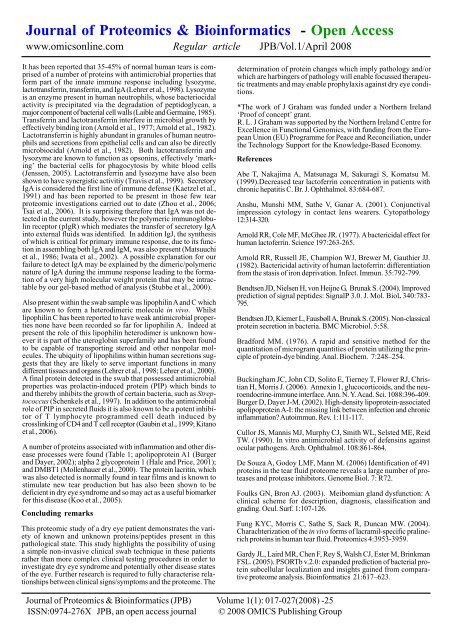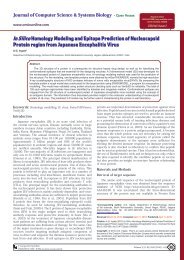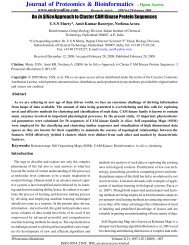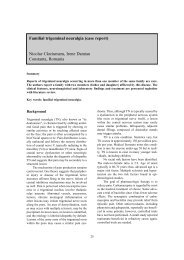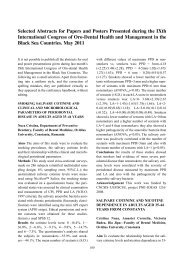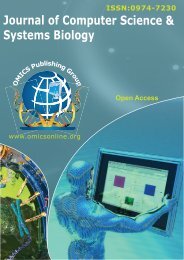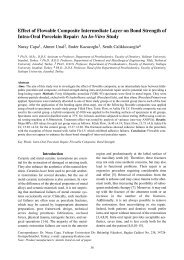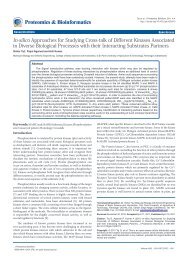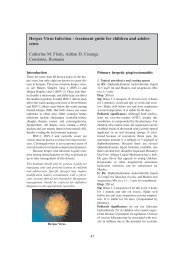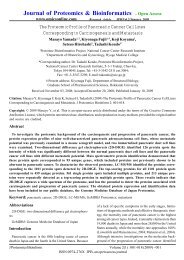Journal of Proteomics & Bioinformatics - Open Access
Journal of Proteomics & Bioinformatics - Open Access
Journal of Proteomics & Bioinformatics - Open Access
Create successful ePaper yourself
Turn your PDF publications into a flip-book with our unique Google optimized e-Paper software.
<strong>Journal</strong> <strong>of</strong> <strong>Proteomics</strong> & <strong>Bioinformatics</strong> - <strong>Open</strong> <strong>Access</strong>www.omicsonline.com Regular article JPB/Vol.1/April 2008It has been reported that 35-45% <strong>of</strong> normal human tears is comprised<strong>of</strong> a number <strong>of</strong> proteins with antimicrobial properties thatform part <strong>of</strong> the innate immune response including lysozyme,lactotransferrin, transferrin, and IgA (Lehrer et al., 1998). Lysozymeis an enzyme present in human neutrophils, whose bacteriocidalactivity is precipitated via the degradation <strong>of</strong> peptidoglycan, amajor component <strong>of</strong> bacterial cell walls (Laible and Germaine, 1985).Transferrin and lactotransferrin interfere in microbial growth byeffectively binding iron (Arnold et al., 1977; Arnold et al., 1982).Lactotransferrin is highly abundant in granules <strong>of</strong> human neutrophilsand secretions from epithelial cells and can also be directlymicrobiocidal (Arnold et al., 1982). Both lactotransferrin andlysozyme are known to function as opsonins, effectively ‘marking’the bacterial cells for phagocytosis by white blood cells(Jenssen, 2005). Lactotransferrin and lysozyme have also beenshown to have synergistic activitiy (Travis et al., 1999). SecretoryIgA is considered the first line <strong>of</strong> immune defense (Kaetzel et al.,1991) and has been reported to be present in those few tearproteomic investigations carried out to date (Zhou et al., 2006;Tsai et al., 2006). It is surprising therefore that IgA was not detectedin the current study, however the polymeric immunoglobulinreceptor (pIgR) which mediates the transfer <strong>of</strong> secretory IgAinto external fluids was identified. In addition IgJ, the synthesis<strong>of</strong> which is critical for primary immune response, due to its functionin assembling both IgA and IgM, was also present (Matsuuchiet al., 1986; Iwata et al., 2002). A possible explanation for ourfailure to detect IgA may be explained by the dimeric/polymericnature <strong>of</strong> IgA during the immune response leading to the formation<strong>of</strong> a very high molecular weight protein that may be intractableby our gel-based method <strong>of</strong> analysis (Stubbe et al., 2000).Also present within the swab sample was lipophilin A and C whichare known to form a heterodimeric molecule in vivo. Whilstlipophilin C has been reported to have weak antimicrobial propertiesnone have been recorded so far for lipophilin A. Indeed atpresent the role <strong>of</strong> this lipophilin heterodimer is unknown howeverit is part <strong>of</strong> the uteroglobin superfamily and has been foundto be capable <strong>of</strong> transporting steroid and other nonpolar molecules.The ubiquity <strong>of</strong> lipophilins within human secretions suggeststhat they are likely to serve important functions in manydifferent tissues and organs (Lehrer et al., 1998; Lehrer et al., 2000).A final protein detected in the swab that possessed antimicrobialproperties was prolactin-induced protein (PIP) which binds toand thereby inhibits the growth <strong>of</strong> certain bacteria, such as Streptococcus(Schenkels et al., 1997). In addition to the antimicrobialrole <strong>of</strong> PIP in secreted fluids it is also known to be a potent inhibitor<strong>of</strong> T lymphocyte programmed cell death induced bycrosslinking <strong>of</strong> CD4 and T cell receptor (Gaubin et al., 1999; Kitanoet al., 2006).A number <strong>of</strong> proteins associated with inflammation and other diseaseprocesses were found (Table 1; apolipoprotein A1 (Burgerand Dayer, 2002); alpha 2 glycoprotein 1 (Hale and Price, 2001);and DMBT1 (Mollenhauer et al., 2000). The protein lacritin, whichwas also detected is normally found in tear films and is known tostimulate new tear production but has also been shown to bedeficient in dry eye syndrome and so may act as a useful biomarkerfor this disease (Koo et al., 2005).Concluding remarksThis proteomic study <strong>of</strong> a dry eye patient demonstrates the variety<strong>of</strong> known and unknown proteins/peptides present in thispathological state. This study highlights the possibility <strong>of</strong> usinga simple non-invasive clinical swab technique in these patientsrather than more complex clinical testing procedures in order toinvestigate dry eye syndrome and potentially other disease states<strong>of</strong> the eye. Further research is required to fully characterise relationshipsbetween clinical signs/symptoms and the proteome. Thedetermination <strong>of</strong> protein changes which imply pathology and/orwhich are harbingers <strong>of</strong> pathology will enable focussed therapeutictreatments and may enable prophylaxis against dry eye conditions.*The work <strong>of</strong> J Graham was funded under a Northern Ireland‘Pro<strong>of</strong> <strong>of</strong> concept’ grant.R. L. J Graham was supported by the Northern Ireland Centre forExcellence in Functional Genomics, with funding from the EuropeanUnion (EU) Programme for Peace and Reconciliation, underthe Technology Support for the Knowledge-Based Economy.ReferencesAbe T, Nakajima A, Matsunaga M, Sakuragi S, Komatsu M.(1999).Decreased tear lact<strong>of</strong>errin concentration in patients withchronic hepatitis C. Br. J. Ophthalmol. 83:684-687.Anshu, Munshi MM, Sathe V, Ganar A. (2001). Conjunctivalimpression cytology in contact lens wearers. Cytopathology12:314-320.Arnold RR, Cole MF, McGhee JR. (1977). A bactericidal effect forhuman lact<strong>of</strong>errin. Science 197:263-265.Arnold RR, Russell JE, Champion WJ, Brewer M, Gauthier JJ.(1982). Bactericidal activity <strong>of</strong> human lact<strong>of</strong>errin: differentiationfrom the stasis <strong>of</strong> iron deprivation. Infect. Immun. 35:792-799.Bendtsen JD, Nielsen H, von Heijne G, Brunak S. (2004). Improvedprediction <strong>of</strong> signal peptides: SignalP 3.0. J. Mol. Biol. 340:783-795.Bendtsen JD, Kiemer L, Fausbøll A, Brunak S. (2005). Non-classicalprotein secretion in bacteria. BMC Microbiol. 5:58.Bradford MM. (1976). A rapid and sensitive method for thequantitation <strong>of</strong> microgram quantities <strong>of</strong> protein utilizing the principle<strong>of</strong> protein-dye binding. Anal. Biochem. 7:248–254.Buckingham JC, John CD, Solito E, Tierney T, Flower RJ, ChristianH, Morris J. (2006). Annexin 1, glucocorticoids, and the neuroendocrine-immuneinterface. Ann. N. Y. Acad. Sci. 1088:396-409.Burger D, Dayer J-M. (2002). High-density lipoprotein-associatedapolipoprotein A-I: the missing link between infection and chronicinflammation? Autoimmun. Rev. 1:111-117.Cullor JS, Mannis MJ, Murphy CJ, Smith WL, Selsted ME, ReidTW. (1990). In vitro antimicrobial activity <strong>of</strong> defensins againstocular pathogens. Arch. Ophthalmol. 108:861-864.De Souza A, Godoy LMF, Mann M. (2006) Identification <strong>of</strong> 491proteins in the tear fluid proteome reveals a large number <strong>of</strong> proteasesand protease inhibitors. Genome Biol. 7: R72.Foulks GN, Bron AJ. (2003). Meibomian gland dysfunction: Aclinical scheme for description, diagnosis, classification andgrading. Ocul. Surf. 1:107-126.Fung KYC, Morris C, Sathe S, Sack R, Duncan MW. (2004).Charachterization <strong>of</strong> the in vivo forms <strong>of</strong> lacramil-specific pralinerichproteins in human tear fluid. <strong>Proteomics</strong> 4:3953-3959.Gardy JL, Laird MR, Chen F, Rey S, Walsh CJ, Ester M, BrinkmanFSL. (2005). PSORTb v.2.0: expanded prediction <strong>of</strong> bacterial proteinsubcellular localization and insights gained from comparativeproteome analysis. <strong>Bioinformatics</strong> 21:617–623.<strong>Journal</strong> <strong>of</strong> <strong>Proteomics</strong> & <strong>Bioinformatics</strong> (JPB) Volume 1(1): 017-027(2008) -25ISSN:0974-276X JPB, an open access journal © 2008 OMICS Publishing Group


